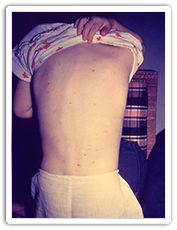Varicella (Chickenpox)
 Varicella is a highly contagious infection caused by the varicella-zoster virus. It is commonly known as chickenpox. It is spread through respiratory droplets in the air formed when an infected person coughs or sneezes It is also spread through direct contact with skin lesions caused by the virus. People infected with chickenpox generally become immune, but they can be at risk of developing shingles later in life.
Varicella is a highly contagious infection caused by the varicella-zoster virus. It is commonly known as chickenpox. It is spread through respiratory droplets in the air formed when an infected person coughs or sneezes It is also spread through direct contact with skin lesions caused by the virus. People infected with chickenpox generally become immune, but they can be at risk of developing shingles later in life.
Image Content Provider: CDC/Ann Cain
Symptoms
Symptoms generally appear within 10 to 21 days after infection. The first symptoms of chickenpox may include mild fever, runny nose and sore muscles.
One to two days after the initial symptoms, an itchy rash may appear. This soon turns into blisters filled with fluid. Children who are infected can become covered with many blisters. These appear mainly on their face, scalp and chest. Blisters that become infected can result in permanent scarring . After approximately five days, the blisters dry out and become crusted. These symptoms usually last 7 to 10 days after the initial symptoms start.
Causes
Chickenpox is a highly contagious infection caused by the varicella-zoster virus and can spread very easily. Children near an infected person who coughs or sneezes have an increased risk of catching the virus. One can also catch the virus by touching an infected person’ s blisters and then touching one’s eyes or mouth. A pregnant mother who has the infection may spread it to her unborn baby.
Treatment
There is no cure for chickenpox. Treatment is focused on relieving the symptoms. Calamine lotion and colloidal oatmeal can be used to help alleviate the itching.
Prevention
Chickenpox can be prevented through immunization. Manitoba has a provincial immunization program, which provides free, publicly-funded vaccines to those who are eligible .
Other precautions can be taken, including taking care not to touch the blisters of infected people and avoiding getting too close to them so as not to inhale their respiratory droplets.
Those infected should stay home and avoid any contact with people until the disease runs its course.
Manitoba Health Resources
For the Public
- Varicella (Chickenpox) Vaccine Factsheet

(April 2014) - Measles, Mumps, Rubella and Varicella (MMRV) Vaccine Fact Sheet

(December 2016)
For Health Care Providers
- Varicella (Chickenpox)

(June 2014) - Immunization Program Manual for Immunization Providers in Manitoba
Other Resources
Communicable Disease
Control (CDC) Health Links – Info Santé |


